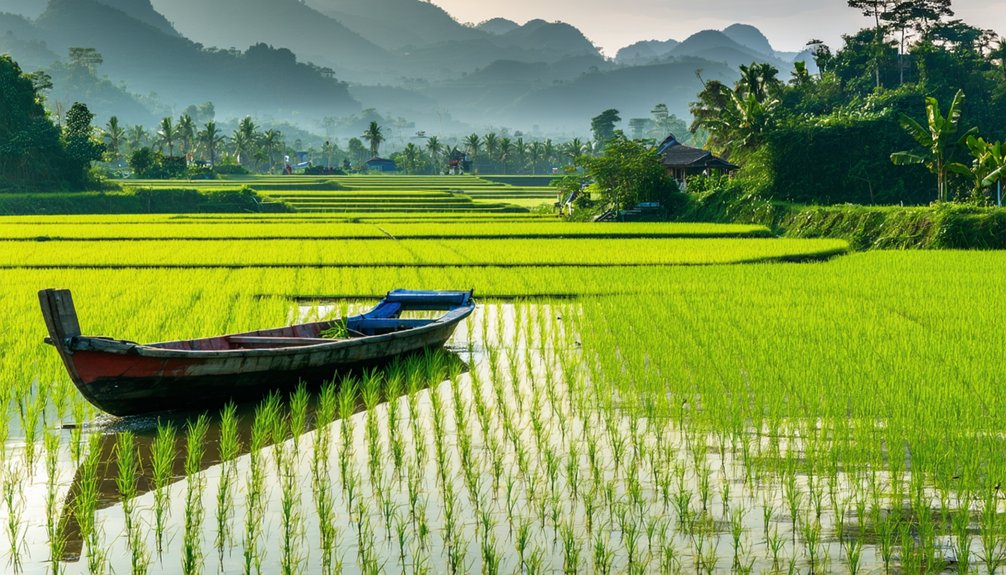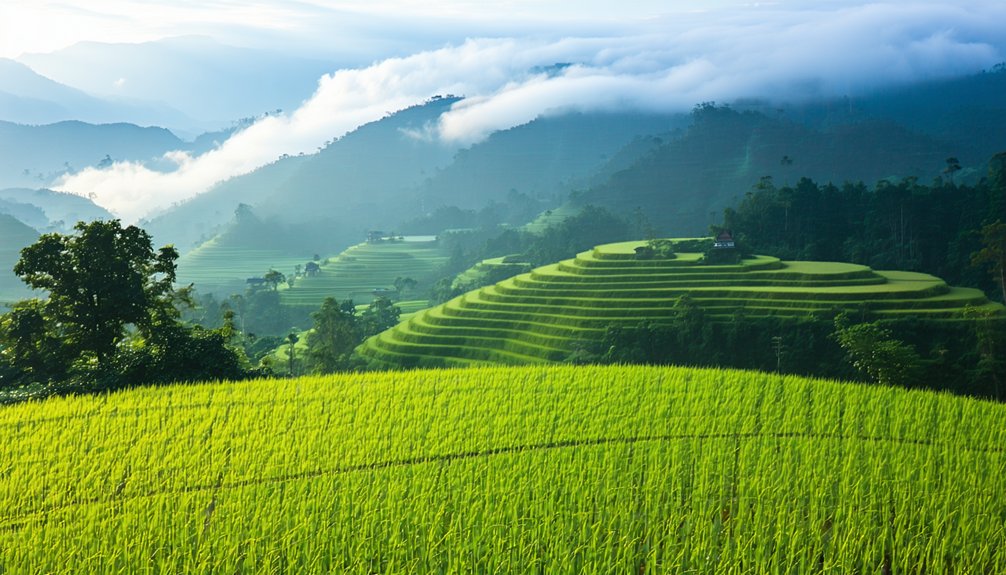You’ll find Thailand’s best weather from November to February during the cool season, with comfortable temperatures around 29°C and minimal rainfall. This peak period offers ideal conditions for exploring temples, beaches, and cities, though you’ll encounter higher prices and larger crowds. If you’re seeking better deals, ponder the shoulder seasons of March-April or September-October, when you’ll still enjoy mostly favorable conditions. There’s much more to bear in mind when timing your Thai adventure perfectly.
Key Takeaways
- November to February offers the best overall weather with clear skies, minimal rain, and comfortable temperatures between 29-34°C.
- Peak season (November-February) requires advance booking 3-6 months ahead and comes with premium pricing but maximum access to activities.
- March-April and September-October are shoulder seasons with reasonable rates and manageable crowds but varying weather conditions.
- May-October offers significant savings up to 50% on accommodations and fewer tourists, though expect occasional rain.
- East and west coast islands have different optimal visiting times: November-April for Phuket/Krabi, April-September for Koh Samui.
Weather Seasons in Thailand: A Complete Overview
Thailand experiences three distinct seasons that shape its climate throughout the year. For travel planning tips, you’ll want to understand how each season impacts your visit.
The hot season spans March through June, with temperatures soaring above 40°C in northern regions during April and May. When packing considerations include lightweight, breathable clothing, you’ll be ready for these intense conditions. The southwest monsoon dominates the rainy season from May to October, bringing its heaviest downpours during September and October. You’ll need waterproof gear and flexible itineraries during these months. In northern Thailand, ground frost occurs in mountainous areas, offering a unique spectacle for visitors.
From November to February, the cool season offers a welcome relief with lower humidity and more moderate temperatures ranging from 30-35°C across the country. This comfortable climate makes outdoor exploration more enjoyable. Your packing list during this period can include light layers for occasional evening chills while maintaining comfort during daytime activities.
Peak vs. Off-Peak Travel Periods

Thailand’s peak tourist season during November-February rewards you with ideal weather and vibrant festivals, though you’ll encounter larger crowds and premium pricing. During the off-peak months of May-October, you can enjoy significant savings on accommodations and flights, with opportunities to experience authentic local culture despite occasional rain showers. March-April and September-October offer the perfect middle ground as shoulder seasons, combining reasonable rates with manageable tourist numbers and generally favorable weather conditions. With tourists spending an average of 9 days per trip, visitors have ample time to explore both peak and off-peak experiences throughout their stay.
High Season Benefits
While planning your Thai adventure, visiting during the high season from November to February offers distinct advantages that can greatly enhance your travel experience. Despite peak crowds and premium pricing, you’ll enjoy optimal weather conditions and vibrant cultural festivities. Travelers should strongly consider getting travel insurance coverage to protect against unforeseen circumstances during their trip.
| Benefit | What You’ll Experience |
|---|---|
| Weather | Clear skies, minimal rain, 29-34°C temps |
| Events | Loy Krathong, Chinese New Year festivities |
| Activities | Prime diving, snorkeling visibility |
| Services | Full operation of tours and transportation |
| Culture | Maximum festival and celebration access |
The high season guarantees reliable weather for outdoor exploration, particularly in the Andaman Sea region. You’ll witness spectacular cultural events like Loy Krathong and have access to fully operational tourist services. Early booking guarantees you’ll secure preferred accommodations and activities, even amid the seasonal rush.
Low Season Advantages
Several compelling advantages await travelers who venture to Thailand during the low season from May to October. You’ll discover drastically fewer crowds at popular attractions, with minimal queues at temples and secluded beaches perfect for peaceful relaxation. The budget-friendly deals are substantial, with accommodation rates dropping 30-50% and flight costs reduced by up to 40%.
You’ll appreciate the flexibility that comes with last-minute bookings and the increased likelihood of room upgrades at resorts. Many hotels offer special perks like complimentary breakfast, while tour operators provide discounted packages for activities like island hopping. Low season visitors can enjoy authentic cultural experiences at unique festivals like the Phi Ta Khon celebration. The natural scenery transforms during this period, as rainfall creates lush landscapes and cooler temperatures averaging 29°C make outdoor exploration more comfortable. Morning sunshine often precedes afternoon showers, allowing for strategic activity planning.
Shoulder Season Sweet Spots
Savvy travelers seeking the perfect balance between cost and comfort will find Thailand’s shoulder seasons particularly rewarding. Visit during March-May or September-October to avoid peak season tradeoffs while enjoying substantial savings of 30-50% on accommodations and flights. You’ll experience shorter wait times at major attractions and more authentic interactions with locals.
For ideal shoulder season timing, consider these regional sweet spots:
- Andaman Coast (Phuket/Krabi): March-April for dry weather and calm seas
- Gulf Coast (Koh Samui): September-October for perfect beach conditions
- Northern Thailand: October-November for lush landscapes post-monsoon
- Bangkok: September-November for cultural events and bearable temperatures
With hotel occupancy at 55-70% versus peak season’s 85-95%, you’ll find more flexibility in booking and enjoy popular destinations without the crushing crowds. Pack lightweight clothing and sun protection for the varying weather conditions during these transition periods.
Regional Weather Differences Across Thailand

Thailand’s climate varies dramatically between the mountainous north, where temperatures can dip to 10°C in winter, and the tropical south, where coastal regions maintain a steady 28-30°C year-round. You’ll encounter distinct weather patterns between the Andaman and Gulf coasts, with the west coast experiencing heavy rains from April to October while the east coast sees its wettest period from October to December. Urban areas like Bangkok in central Thailand face intense heat above 35°C during the dry season, coupled with high humidity that persists throughout the year. The fertile Chao Phraya River basin provides essential conditions for rice cultivation during the monsoon season.
North Vs South Climate
While both regions share the same country, northern and southern Thailand experience dramatically different climate patterns throughout the year. Micro climate nuances create distinct challenges for travelers, affecting everything from seasonal packing considerations to timing your visit.
- Northern Thailand follows a three-season pattern with dramatic temperature swings – from chilly 14°C nights in winter to scorching 40°C days during the hot season. Winter nights can be particularly cold with temperatures dropping to around 5°C in Chiang Mai during December and January.
- Southern regions maintain steady temperatures year-round, typically 30-34°C, with consistently high humidity
- The north receives about 1,400mm of annual rainfall, while the south gets drenched with 2,400mm
- You’ll encounter shorter, intense rainstorms in the north during monsoon season, whereas southern rains are more prolonged and predictable, especially on the west coast
Coastal Weather Patterns
To understand Thailand’s full weather story, you’ll need to look beyond the north-south divide to its extensive coastlines. The west coast along the Andaman Sea experiences heavy rains from May to October, while the Gulf of Thailand‘s east coast sees its wettest period from September to December.
These distinct patterns create fascinating microclimate variations. You’ll find the Rayong-Chanthaburi corridor sheltered from summer rains, while Koh Chang receives nearly triple the rainfall of nearby Koh Samet. These weather differences directly influence tourism impact patterns – west coast destinations like Phuket peak from November to April, while east coast hotspots like Koh Samui draw crowds from February to August. The annual rainfall in Trat can reach up to 3,500 mm during peak monsoon months. Water temperatures stay inviting at 28-30°C year-round, though you’ll want to watch for monsoon-driven rough seas that can affect diving and ferry schedules.
Seasonal Urban Heat
Cities across Thailand tell a dramatic tale of temperature extremes, where urban zones consistently run 2-4°C hotter than their rural counterparts throughout the year. You’ll experience this urban heat intensity most dramatically in major cities, where concrete jungles and reduced vegetation create challenging microclimates that require smart urban heat mitigation strategies. March to April tends to be oppressively hot in cities, making coastal destinations more appealing during these months.
- Northern cities like Chiang Mai reach scorching urban temperatures of 47.19°C during March-May
- Bangkok’s urban heat peaks at 6-7°C above rural areas in dry seasons
- Coastal southern regions maintain lower 2°C urban-rural differences
- Nighttime temperatures stay elevated at 31-32°C in cities versus 27-30°C in rural areas
Through microclimate management techniques, you can navigate these thermal challenges by timing your visits during the wet season when urban-rural temperature gaps narrow considerably.
Major Thai Festivals and Cultural Events

Thailand’s two most iconic festivals showcase the nation’s deep spiritual and cultural heritage. Songkran, held April 13-15, transforms streets into joyous water battles while honoring traditional water-based rituals. You’ll witness locals visiting temples, blessing elders, and participating in nationwide water fights that symbolize purification. In November, Loi Krathong illuminates waterways with thousands of floating banana-leaf baskets, offering gratitude to the water goddess. The Yi Peng festival adds to the enchanting atmosphere as thousands of paper lanterns fill the night sky.
Festival | Date | Key Features
—|—|—
Songkran | April 13-15 | Water fights, temple visits, UNESCO heritage
Loi Krathong | November Full Moon | Floating baskets, candle ceremonies
Boon Bang Fai | Mid-May | Rocket launches, rain prayers
For agricultural harvest celebrations, head to northeastern Thailand in mid-May. The Boon Bang Fai Rocket Festival features homemade rockets launched skyward in a spectacular display meant to encourage rainfall for crops. These vibrant celebrations offer you unparalleled insights into Thailand’s cultural identity and spiritual traditions.
Coastal Destinations: When to Visit Each Coast

While festivals offer cultural immersion throughout Thailand, the timing of your coastal visits can make or break your beach experience. The Andaman Sea’s western shores shine from November to May, offering prime shore excursion options and crystal-clear waters for diving. Meanwhile, the Gulf of Thailand‘s eastern coast beckons from January through September, with favorable island accessibility during the summer months. Given that the Andaman Sea region experiences its rainy season from June to October, planning around these months is crucial for optimal weather.
For the ultimate coastal experience, consider these strategic timing tips:
- Target November-February for island hopping across both coasts, when you’ll enjoy calm seas and sunny skies
- Hit the Andaman Sea from March-May for fewer crowds and budget-friendly rates
- Explore the Gulf islands July-September for vibrant beach parties and perfect diving conditions
- Leverage the staggered monsoon seasons by alternating between coasts – when one side’s stormy, the other’s often sunny
Remember to book accommodations 3-6 months ahead during peak seasons to secure your ideal coastal escape.
Budget-Friendly Travel Months

Savvy travelers looking to explore Thailand on a budget should focus on the low season months of May through October, when prices plummet across the country. You’ll find flights from the U.S. at nearly half the peak season rates, often ranging from $600-$800 round-trip, while accommodations offer 30-50% discounts.
Among the budget travel best practices, consider targeting shoulder months like November and early December for an ideal balance of cost and comfort. The weather’s cooler, crowds are thinner, and you’ll still enjoy significant savings. During these months, a daily budget of 25-30 USD is sufficient for backpackers. For perfect low season activities, embrace afternoon showers by exploring temples and museums, or head to the Gulf Coast where May-July stays relatively dry. You can stretch your budget further with street food adventures, hostel stays, and local transport. Don’t forget to negotiate long-stay discounts during these quieter months – many accommodations will offer 10-30% off for extended bookings.
Northern Thailand’s Weather Patterns

Understanding Northern Thailand’s weather patterns is essential for planning your visit, as the region experiences three distinct seasons throughout the year. Regional microclimates, influenced by altitude variations, create diverse conditions that can substantially impact your travel experience.
Planning your Northern Thailand journey requires understanding its three seasons and diverse microclimates shaped by varying altitudes.
The southwest monsoon dominates from May to November, bringing heavy rains and potential disruptions to outdoor activities. You’ll find the most pleasant conditions during the cool season (November-February), with daytime temperatures around 28°C and invigoratingly cool nights at 13°C. The first two months of the year offer particularly clear skies with 19% cloud cover.
Key weather considerations for Northern Thailand:
- March-April brings peak heat (36°C) with low humidity (55%)
- July-August sees intense rainfall (up to 190mm) with frequent flash floods
- Mountain areas experience sharper temperature shifts than valleys
- Winter inversions create foggy mornings from November-February
The region’s unique geography means coastal monsoons have minimal impact on inland humidity, while mountainous zones offer year-round travel possibilities with proper planning.
Planning Around Temperature and Rainfall

Building on Northern Thailand’s weather patterns, successful trip planning for any Thai destination requires careful consideration of both temperature and rainfall variations throughout the year. You’ll find the most pleasant conditions from November through February, when temperatures hover between 30-35°C and humidity levels drop significantly.
Watch for seasonal precipitation levels that vary dramatically by region. While the Andaman Coast experiences heavy rains from May to October, the Gulf Coast sees its wettest period from October through January. Humidity fluctuations play an essential role in comfort – expect levels above 80% during the wet season, making even moderate temperatures feel more intense. Thailand receives between 1,200 to 4,500 millimeters of annual rainfall due to the monsoon patterns.
For maximum flexibility, target November-February for mainland explorations. If you’re heading to the islands, align your visit with each coast’s dry season: November-April for Phuket and Krabi, or April-September for Koh Samui. March and April bring intense heat nationwide, so plan indoor activities during peak afternoon hours.
Essential Booking Tips by Season

A traveler’s calendar shapes the entire booking strategy for Thailand’s distinct seasons. During high season (November-February), you’ll need to book 3-6 months ahead, especially for beach destinations. Seasonal price fluctuations are most dramatic during December-January, when premium rates peak at coastal resorts. Thailand’s vibrant nightlife and attractions are most accessible when visiting during the high season in December.
For maximum value, consider these strategic booking windows:
- Secure up to 50% off luxury stays during May-June’s rainy season, but verify trip cancellation policies
- Target March-April for southern islands, enjoying discounted rates before monsoon arrives
- Book Songkran Festival accommodations (April) at least 6 months in advance
- Focus on east-coast islands during July-September for better weather conditions
The shoulder seasons offer excellent opportunities for spontaneous urban exploration, with last-minute hotel deals available in Bangkok and Chiang Mai. For island destinations, always check regional weather patterns before committing to non-refundable bookings.





